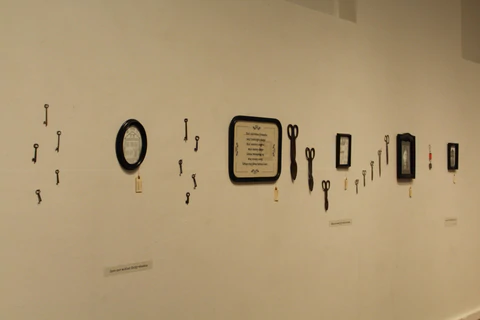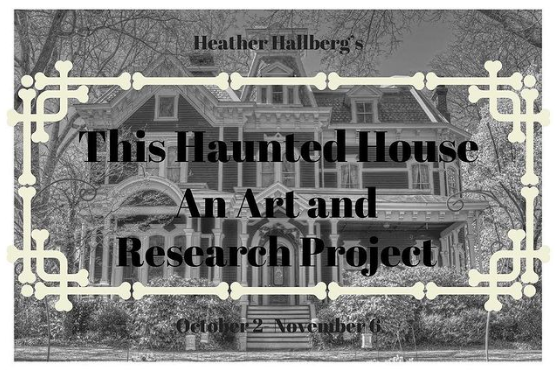This Haunted House 2017

This Haunted House is an ongoing art and research project by Heather Hallberg, featuring multiple mediums and styles to recreate Victorian homes, and the ghosts that may haunt them.
Installation #1 features the Andrew J. Borden house and Maplecroft, both of Fall River, MA.
On August 4, 1892, Andrew Borden and his wife, Abby Borden, were ruthlessly murdered in their home on Second Street. The primary suspect for the infamous and bloody axe murders was Andrew’s daughter, Lizzie, who lived in the house along with Andrew, Abby, and Lizzie’s sister, Emma.
While Lizzie was tried and acquitted in the murders, and no other guilty party was ever accused, the infamy of the murders and the reputation of being a murderess followed Lizzie to the grave.
...
The Borden House, built in 1840, is a classic example of the Greek Revival style of the time, popular from 1815 to the 1860s. While Thomas Jefferson was a strong proponent of the Roman Classical style, many Americans felt it was too strongly tied to the styles of England, having just fought the War of 1812. Greek archaeological finds around this time also seemed to imply that Roman culture had been influenced by the Greeks, so popularity shifted towards the Greek style.
Greek Revival architecture benefitted immensely from the Industrial Revolution’s increase in cheap labor and materials, and the rise of a wealthier middle-class, who could now afford more elaborate housing designs. Normally homes were painted white to mimic Greek marble, but Lizzie had the house painted in Drab (already out of style) colors in the spring of 1892.
Identifying markers of the Greek Revival style are:
- A gabled or hipped roof with a low pitch
- Entry of full-width porch, supported by columns
- Cornice line, emphasized with a wide band of trim
- Narrow line of transom
- Sidelights around the entry door
- 6 over 6, double-hung windows
- Typically white paint scheme
The Borden House does not have all of these features; most windows are 4 over 4, and the only transom is over the kitchen door. Variations were common, and some of these changes may have been made by Andrew Borden, who did not build the house originally. Mr. Borden was known to be a penny-pincher, so it is unlikely that he made any unneeded changes. Despite being able to afford such luxuries, the home did not have running water or electricity, and used oil lamps instead of gas.
The waterside city of Fall River was booming during the late 1880s due to numerous mills in the area that were powered by the waterway and employed thousands of workers. Sadly, the area was devastated by the Great Depression and an enormous fire that consumed the mill district in the late 1920s.
The Borden House still stands today, and is a bed and breakfast museum, which has been painstakingly and authentically furnished and remodeled based on crime scene photos from 1892. Visitors can tour the murder scenes, see displays of artifacts including Mr. Borden’s mutilated skull, and spend a spooky night in the supposedly haunted rooms.
After Lizzie was acquitted in the axe murders of her father and stepmother, she and her sister, Emma, inherited quite a sum of money from their father’s estate. This allowed the sisters to move to another home in Fall River, which Lizzie named “Maplecroft.” The 8 bedroom mansion helped Lizzie, who now went by Lizbeth, to escape some of the public scrutiny she faced, despite being found innocent of the double-homicide.
Lizbeth and Emma lived together in Maplecroft until 1905, when a spat between the sisters revolving around Lizbeth’s actress friend, and possible lover, Nance O’Neill, caused Emma to move out. It is reported that the sisters never saw each other again. Perhaps it is fitting they died just 9 days apart; Lizbeth on June 1, 1927, and Emma on June 10, 1927.
…
Maplecroft was much more of a mansion than the original Borden home was, especially bourgeois in comparison. In the Queen Anne Victorian style, which was popular from 1880-1910, the expansive home allowed Lizbeth to hold parties for her friends, play with her dogs, and read by the fireplace.
Queen Anne architecture can be recognized by:
- An asymmetrical facade
- Dominant front-facing gable, often cantilevered beyond the plane of the wall below
- Overhanging eaves
- Round, square, and polygonal towers
- A porch covering part or all of the front facade
- Oriel and bay windows
- Massive chimneys
- Wrap-around porch, often in an ‘L’ shape
Maplecroft has many of these features; the construction of the stone chimney in the back of the home was overseen by Lizbeth herself, and the front facade is indeed asymmetric. The fireplaces inside, of which there are 6, feature elaborate carvings and poems; everything was custom-built just a few years prior to the Borden sisters purchasing the home.
Maplecroft still stands in the Highlands district, and has recently been completely refurbished to its original glory for use as a bed and breakfast. It is now for sale, for only $850,000! A small price to pay to enjoy the luxury that Lizbeth and Emma did at the turn of the century, with possible ghosts included.
Pictures from the installation at the Carnegie Center:




